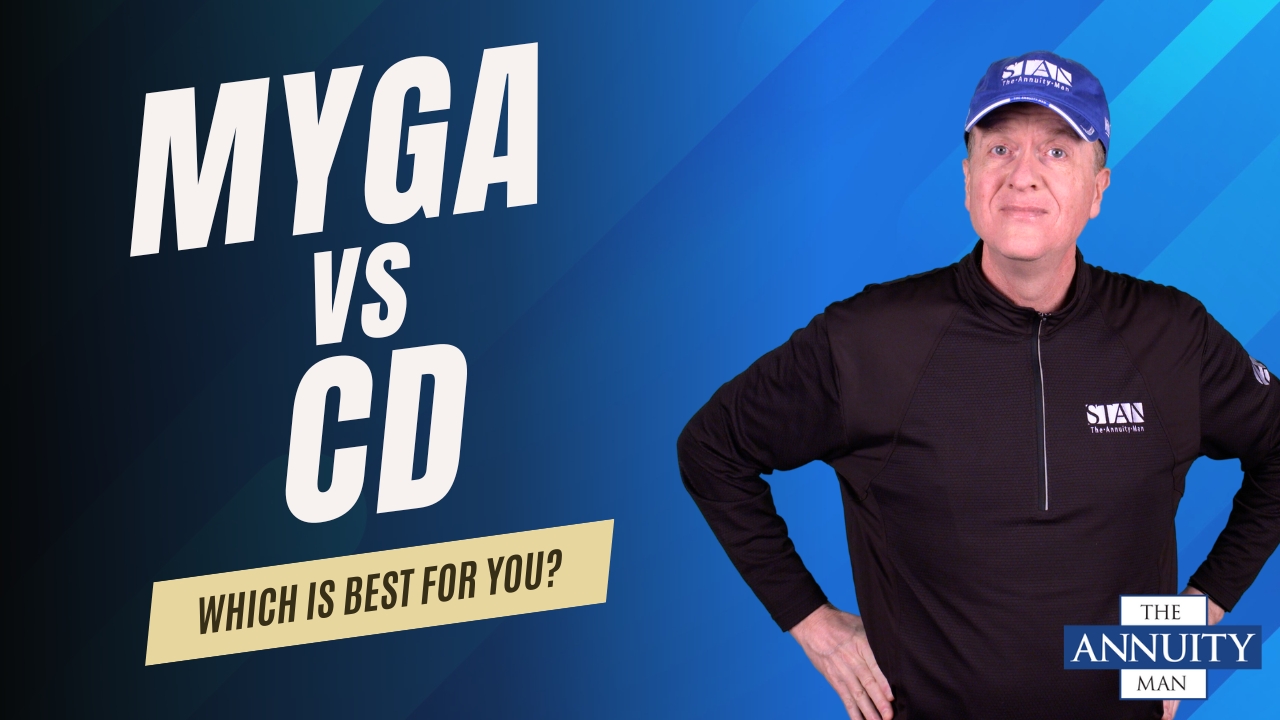Table of Contents
How Do Annuity Payouts Work?

Someone asked a great question: "How do annuity payouts work?" "Hey, Stan, I thought all annuities were the same. Hey, Stan, this guy on television said, 'I hate all annuities.' Hey, Stan, my broker, advisor, and master of the universe said never to look at annuities." Hating all annuities and grouping all annuities is like saying, "I hate all restaurants. I hate all trucks. I hate all socks. I hate all shoes. I hate all shirts." It's stupid. There are so many different types of annuities, but we'll talk about the ones that create payouts and also tell you some things that agents say aren't true regarding payouts. But of course, I'm going to do that. I'm the walking middle finger of annuity truth. And you know that, and you love that about me because you know you'll get the brutal facts about this crazy topic called annuities. After all, I'm Stan The Annuity Man®.
Three Types of Annuity Payouts
How do annuity payouts work? Let's go through the three types, and then I'm going to dig in. Here they are. You can peel off interest from a Fixed-Rate Annuity and a MYGA. You can annuitize, and there are three specific lifetime income products that do annuitization. Think of annuitization, the way I explain it, in my southern speak from the Carolinas, is you have the water spigot in the back of the house. If you rip the knob off, the water spigot water is just coming, and you can't shut it off. When you annuitize and create a lifetime income stream, it's the same thing. Income is coming. I mean, you can't shut it off. It's over. It's coming. The only way to shut it off is to die. The third way is what's called Income Riders. Income Riders have been very popular since 2008, when we had that little hiccup in the markets. Income Riders have become very popular. They're not annuitization, meaning you're not ripping the knob off the water faucet, and income's flowing, and you can't stop it. Lifetime income is still the guarantee, and it's still contractual, and as long as you are breathing with Income Riders, but it's not annuitization. You still control the asset. It's lifetime income, but you still control the asset. A lot of people like that. That doesn't make it better than annuitized products. It's just a different way to get to that lifetime income contractual guarantee.
So, there are only three. But let me bring up one that agents tout as income, and it's not. They'll say, "Well, if you buy this annuity, you can take out 10% penalty free annually from the policy." That's not income. That's taking your own money out. That's like saying, "Well, you put your money in the bank, and you take your money out of the bank; that's income." No, that's taking your money out of the bank. Same thing with these sales pitches. I had a call the other day, and he goes, "Well, this guy pitched me an annuity. It's a 35% upfront bonus, and I get to take 10% out yearly." I'm like, "Stop. You're killing me." Number one, upfront bonuses, candy for the ridiculous. Don't be ridiculous. And number two, 10% free withdrawal, who cares? Great, you have liquidity, but it's only for liquidity if you need it. It's not a strategy.
Let's get back to the three types of annuity payouts. Let's talk about the interest. Let's say you're buying Multi-Year Guarantee Annuities. Yes, you can go to my live MYGA rates and see the best live feed of the best-fixed rates for your specific state. But it's like buying a CD, or if you own a bond, peeling off the coupon of a bond. Let's say you bought a five-year Multi-Year Guaranteed Annuity, Fixed Rate Annuity, and it's three or three and a half percent, whatever it is at the time of this blog. Hopefully, it's higher if you're reading this down the road.
Now, with a lot of the carriers, you can peel off that interest and never touch the principal but peel off the interest. Sound familiar? Like a CD? Remember that? You could do that with the Jimmy Carter CD, same thing. You can peel off that interest, and in some people's world, that's a payout. People say, "Well, I never want to touch the principal, but I want to know that the principal's there. I don't want to annuitize it. I don't want to turn it on for the lifetime income stream, but I want to peel off the interest as a form of a payout to the wife and me and the spouse or whoever." I'm like, "Perfect. Then buy a Multi-Year Guaranteed Annuity and peel off the interest."
The second way for a payout is Single Premium Immediate Annuities, Deferred Income Annuities, and another type of Deferred Income Annuity called a Qualified Longevity Annuity Contract that can be used inside your traditional IRA. Suppose you have someone that says, "Never, ever, ever, ever buy annuities outside of an IRA, never, never, never, never, never, never. They're ridiculous, and they're not informed. They need to read more and watch more Stan The Annuity Man videos because QLACs were put on the planet for use with your traditional IRA. And the IRS and the Department of the Treasury were the ones that introduced it, not Stan Annuity Man.
When you hear stuff that sounds really ridiculous, when people comment about annuities, and they're making this broad brush of view, "I hate all annuities, never buying an annuity. Annuities are all expensive. Never put an annuity inside of an IRA." Those people are not intelligent, and they need to stop talking. It'd be like me being a color commentator for ballerinas, and it would make no sense at all. Annuitization products come down to when you need the income to start. Always ask two questions. What do you want the money to contractually do? When do you want those contractual guarantees to start?
Examples
Let's take a couple of examples. Let's say income is the first answer, but the second answer determines what you're going to use as a product. If you say, "I need income to start immediately or within one year," that's a Single Premium Immediate Annuity, period. We shop all carriers. Use my annuity calculators to see the contractual guarantees, and then contact us for customization quotes. If you say, "I might need it like a year and a half from now, two years from now, seven years from now, five years from now," whatever that is, that income later® type thought, then that could be a Deferred Income Annuity and a Qualified Longevity Annuity Contract. Just understand the older you are, the higher the payment and interest rates play a secondary pricing role. But once you turn on that income with SPIAs, DIAs, and QLACs, it's game on, it's income on, and you can't shut it off, period.
Payout Structure
We can structure it so that 100% of any unused money goes to the beneficiary when you die. So, all the people out there, "well, I'd never buy an annuitization product because when I die, the insurance company keeps the money." That's only one of about 40 ways to structure it player, so if you don't want that, if you say, "I've worked hard for my money. I want the lifetime income stream. I want to transfer the risk to the annuity company, but when I die, when my Learjet hits the mountain, when my Dodge Ram truck hits the tree, I want whatever money's left in that account to go to my beneficiaries. We can do that even though the annuity company's on the hook to pay, regardless of how long you breathe. By the way, there's no ROI until you die because it's a transfer of risk. Those are the annuitization products from a payout mode.
The third one is Income Riders. Income riders are very popular. Now, it's not a standalone product. I had a guy call in the other day. "You know, I've read all your books. I like the Income Rider owner's manual, Stan, and I want to buy that. I don't want to attach it to anything, and I just want to buy the Income Rider." I'm like, you can't do that, player. The Income Rider is attached at the time of application to either an Index Annuity or a Variable Annuity. We don't sell Variable Annuities because you own an annuity for what it will do®, not what it might do. I don't do variables. I don't do anything that can go down in value. And the Income Riders attached to Index Annuities are traditionally and usually higher from a contractual guarantee standpoint than Variable Annuities. If you're looking at contractual guarantees, not hypothetical, theoretical, projected back tested unicorns chasing the butterflies returns that you hear, okay.
Please never make a decision on, "well, if you'd owned it 10 years ago, Mr. Jones, you'd done this." That's crap. If you had done a hundred sit-ups a day for the last 10 years, you'd have six-pack abs, and you didn't do that. Look at it the same way, but Income Riders are good. It's income later. If you said to me, "Hey, Stan, I want income to start in seven years," we're going to quote DIAs, we're going to quote Income Riders, and if it applies using your IRA, we will quote QLACs—income later, income at a future date. We will quote all carriers for those product types for the highest contractual guarantee. Then, I will tell you each strategy's limitations and benefits, the good and the bad. They're not too good to be true. They have limitations.
Income Riders
Let's look at, visually, at Income Riders. Draw a line down a blank sheet of paper. On one side will be the accumulation value, real money. The cash value. It depends on the Income Rider you're attaching, whether it's indexed option call options or Variable Annuity. And on the other side will be Income Riders. It's a phantom account. It's Monopoly money, and it grows at these elegant Jimmy Carter interest rates. And you go, "wait a minute, Stan. This guy told me I could get a 35% upfront bonus and 8% growth on the Income Rider." It's Monopoly money player. You can't peel off the interest, cash it in, or transfer it, but you can use that side, this Income Rider's side, to calculate your lifetime income when you turn on the income stream. "Why does that happen, Stan?" Good question. Because annuity companies have the big buildings for a reason, and for you to take advantage of that higher valuation on the Income Rider side, you have to turn on a lifetime income stream, which means the annuity company keeps the money as they're doing it back to you over your life expectancy. That's an Income Rider.
The other thing to keep in mind about Income Riders is once you have an Income Rider attached to a policy, it's tough to transfer it to another policy because you have to show it during the application process. I have to show that where you're moving to is mathematically better than where you're coming from. Please do not let some grifter tell you, "Well, let's move it because you're going to get an upfront bonus." That is illegal, and that's crazy talk. If you're an agent, listen to this. Please don't do that.
We've gone over the three types of payouts, interest, peeling off interest like on a MYGA, annuitization, and Income Riders. And remember, ask yourself two questions. What do you want the money to contractually do, and when do you want those contractual guarantees to start? And then go to my annuity calculators and quote until your heart's content. Run quotes, it's fantastic, and I will pay for it. That's the philanthropist I am. The annuity philanthropist, CEO. Write that down. We need to trademark that. Listen, thanks so much for reading today's blog. Tell your friends and non-friends, and let them know about all the information you've read in the Stan The Annuity blogs.
Never forget to live in reality, not the dream, with annuities and contractual guarantees! You can use our calculators, get all six of my books for free, and most importantly book a call with me so we can discuss what works best for your specific situation.
.png)
.svg)
















.jpg)


.jpg)
.jpg)
.jpg)
.jpg)

.jpg)



.jpg)
.jpg)
.jpg)
.jpg)
.jpg)
.jpg)
.jpg)


.jpg)
.jpg)
.jpg)
.jpg)

.jpg)
.jpg)


.jpg)

.jpg)

.jpg)

.jpg)
.jpg)
.jpg)

.jpg)
.jpg)
.jpg)

.jpg)
.jpg)
.jpg)


.jpg)







.jpg)

.jpg)

.jpg)



.jpg)
.jpg)

.jpg)
.jpg)
.jpg)
.jpg)
.jpg)
.jpg)
.jpg)
.jpg)
.jpg)
.jpg)
.jpg)
.jpg)
.jpg)
.jpg)
.jpg)

.jpg)
.jpg)
.jpg)

